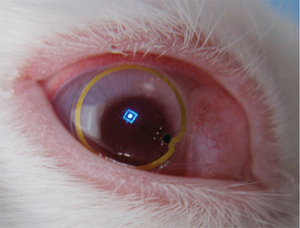Hands-free information could stream across your contact lens, in a device that came one step closer to reality this week.
In a new paper, University of Washington researchers demonstrated the safety of a prototype device tested in the eye of a rabbit.
At the moment, the contact lens device contains only a single pixel of information, but the researchers say it is a proof of the concept that the device could be worn by a person. Eventually it could display short emails and other messages directly before a wearers eyes.
 |
|
Lens contains single pixel of information.(Photo Credit: University of Washington) |
“This is the first time we have been able to wirelessly power and control the display in a live eye,” said Babak Parviz, an author and UW associate professor of electrical engineering. Among his coauthors are Brian Otis, associate professor of electrical engineering, and Andrew Lingley, a graduate student.
The researchers findings were published Nov. 22 in the Journal of Micromechanics and Microengineering.
Perhaps the best-known science fiction character to use such a display is the Terminator, and for almost seven years Parviz and others have worked on trying to make the display a reality.
Building the lenses required researchers to make circuits from metal only a few nanometers thick, about one-thousandth of a human hair. They built light-emitting diodes (LED) one-third of a millimeter in diameter. And to help focus the images, the researchers made arrays of tiny lenses that were put into the contacts.
The contact lens has an antenna to take power from an external source, as well as an integrated circuit to store this energy and transfer it to a transparent sapphire chip containing a single blue LED.
Otis called this successful wireless transmission to a lens “an extremely exciting project … that presents huge opportunities for health-care platforms.” The team is working on a way to monitor a diabetic patients glucose level using lenses.
The UW researchers collaborated with a group at Aalto University in Finland. Other authors from the UW are Yudo Liao and Ramin Mirjalili, both former graduate students, and Tueng Shen, an associate professor of both ophthalmology and bioengineering.












